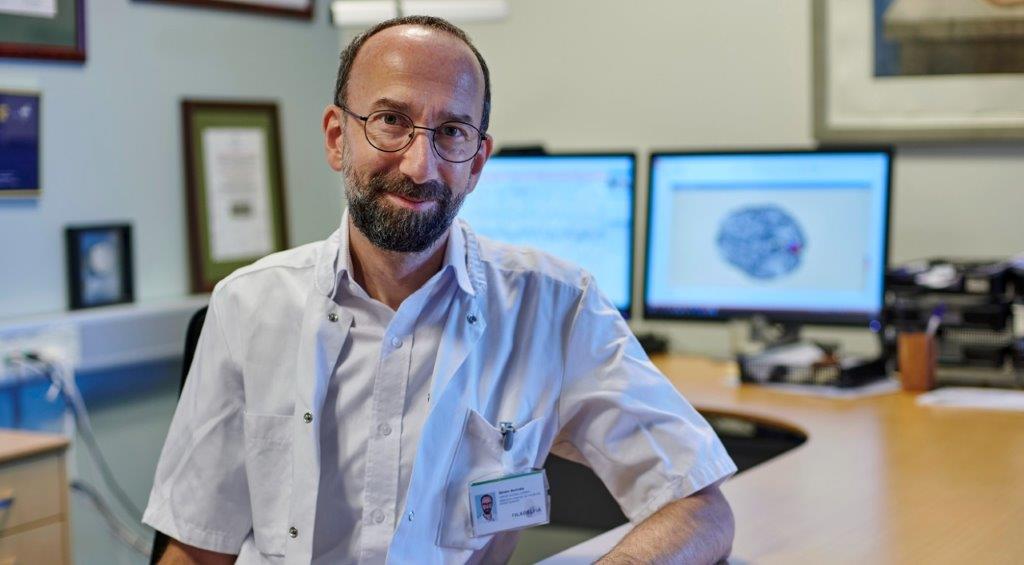
Researcher
Sándor Beniczky
Academic Qualifications
Professor Sándor Beniczky is the Head of the Department of Diagnostics and Cross-Functional Services at Danish Epilepsy Centre, Filadelfia, and a Senior Consultant at the Department of Clinical Neurophysiology at Aarhus University Hospital. He is a board-certified neurologist from the University of Szeged, Hungary.
- Editor-in-Chief of Epileptic Disorders
- Member of the EEG Task Force, ILAE Commission on Big Data
- Former Chairman of the Joint Taskforce on EEG of the International Federation of Clinical Neurophysiology and ILAE
- Member of the ILAE Commission on Diagnostic Methods
- Member of the ILAE Education Council, Coordinator of the Virtual Epilepsy Academy (VIREPA)
- Member of the ILAE Education Council, Coordinator of the Virtual Epilepsy Academy (VIREPA)
- Member of the ILAE Congress Council
Watch the Film about Sándor Beniczky
Sándor Beniczky’s research
Artificial Intelligence and EEG Although EEG is an important method for diagnosing epilepsy, interpreting the collected electrical signals requires specialized expertise. This means that not all places in the world have access to the necessary experts to analyze these data. Researchers are working on developing and testing artificial intelligence (AI) algorithms. These are like ‘brains’ for computers that can learn to analyze EEG data in a way similar to what human experts do. The goal is to make it easier to assess EEG results. By using AI algorithms to analyze EEG data, patients can be helped, especially in third-world countries where access to specialists may be limited.
The algorithms can also assist the experts who already work with these data by reducing the workload and possibly providing a more detailed analysis of brain activity. In the long term, AI algorithms can also be used in portable medical devices, such as smartphones or wearables, to monitor and automatically detect epileptic seizures. This can be a valuable aid for people living with epilepsy, as it can give them and their doctors earlier warnings of seizures and potentially improve treatment.
In short, this research is about using artificial intelligence to make it easier to analyze EEG tests to help patients with epilepsy, especially in areas with limited access to specialized expertise, and also to improve monitoring and early detection of seizures.
Source Localization EEG source localization is an important process in the treatment of epilepsy, especially when surgical intervention is necessary. When someone has a specific type of epilepsy where focal seizures begin in a particular area of the brain, it is crucial to find exactly where this area is. This is called the ‘epileptic focus.’ Finding the right spot is essential if surgery to remove the problematic area is being considered. To achieve this, doctors use two important tools:
EEG (Electroencephalography), where small sensors are placed on the patient’s head to measure the electrical signals the brain emits. These signals can provide doctors with information about where in the brain the seizures start.
Magnetic Resonance Imaging (MRI) scans create images of the brain that can show detailed structures within the brain. They help doctors see what the brain looks like inside. In short, EEG source localization involves using mathematical methods to combine information from EEG and MRI scans to pinpoint the exact location in the brain where epilepsy begins, aiding doctors in deciding how best to help the patient.
Mobile Devices for Epilepsy One of our key research areas is the development and validation of mobile devices for automatic seizure detection.
The purpose of mobile devices is to continuously monitor patients’ conditions and automatically record when they experience a seizure. Some types of seizures—major convulsive seizures—are potentially dangerous. When a seizure is detected, the device triggers an alarm or notification so that the patient, their relatives, or healthcare personnel can intervene and help.
The technological advancements are particularly important as they can improve the safety and quality of life for people with epilepsy. Researchers and developers are working to develop and validate mobile devices for automatic seizure detection, ensuring these devices are reliable and accurate in detecting seizures. This can help reduce the risk of injury and provide patients and their relatives with greater peace of mind in their daily lives.
Research Field
- Epileptic brain activity and thereby more precise diagnosis
- Development and clinical validation of automatic seizure tracking.





